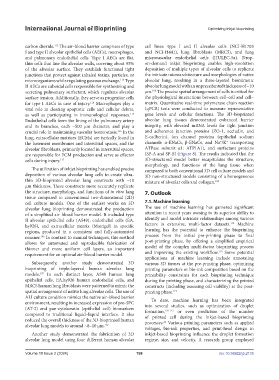Page 206 - IJB-10-2
P. 206
International Journal of Bioprinting Optimizing inkjet bioprinting
carbon dioxide. The air–blood barrier comprises of type cell lines: type I and II alveolar cells (NCI-H1703
112
I and type II alveolar epithelial cells (AECs), macrophages, and NCI-H441), lung fibroblasts (MRC5), and lung
and pulmonary endothelial cells. Type I AECs are flat, microvascular endothelial cells (HULEC-5a). Drop-
thin cells that line the alveolar walls, covering about 95% on-demand inkjet bioprinting enables high-resolution
of the alveolar surface. They establish functional tight deposition of multiple types of alveolar cells to replicate
junctions that protect against inhaled toxins, particles, or the intricate microarchitecture and morphologies of native
113
microorganisms while regulating gaseous exchange. Type alveolar lung, resulting in a three-layered biomimetic
II AECs are cuboidal cells responsible for synthesizing and alveolar lung model with an unprecedented thickness of ~10
108
secreting pulmonary surfactant, which regulates alveolar µm. The precise spatial arrangement of cells is critical for
surface tension. Additionally, they serve as progenitor cells the physiological interactions between cell–cell and cell–
for type I AECs in case of injury. Macrophages play a matrix. Quantitative real-time polymerase chain reaction
114
vital role in clearing apoptotic cells and cellular debris, (qPCR) tests were conducted to measure representative
as well as participating in immunological responses. gene levels and cellular functions. The 3D-bioprinted
115
Endothelial cells form the lining of the pulmonary artery alveolar lung tissues demonstrated enhanced barrier
and its branches, each ~500 µm diameter, and play a integrity, with elevated mRNA levels for tight junction
crucial role in maintaining vascular homeostasis. In the and adherence junction proteins (ZO-1, occludin, and
116
lung, extracellular matrices (ECMs) are typically found in E-cadherin), ion channel proteins (epithelial sodium
+
+
the basement membranes and interstitial spaces, and the channels: α-ENaCs, β-ENaCs, and Na /K transporting
alveolar fibroblasts, primarily located in interstitial spaces, ATPase subunit α1: ATP1A1), and surfactant proteins
are responsible for ECM production and serve as effector (SP-A and SP-B) (Figure 8). The results indicated that the
cells during injury. 3D-structured model better recapitulates the structure,
117
morphology, and functions of the lung tissue when
The utilization of inkjet bioprinting has enabled precise compared to both conventional 3D cell culture models and
deposition of various alveolar lung cells to create ultra- 3D non-structured models consisting of a homogeneous
thin 3D-bioprinted alveolar lung constructs with ~10 mixture of alveolar cells and collagen.
108
µm thickness. These constructs more accurately replicate
the structure, morphology, and functions of in vitro lung 7. Outlook
tissue compared to conventional two-dimensional (2D)
cell culture models. One of the earliest works on 3D 7.1. Machine learning
alveolar lung bioprinting demonstrated the production The use of machine learning has garnered significant
of a simplified air–blood barrier model. It included type attention in recent years owning to its superior ability to
II alveolar epithelial cells (A549), endothelial cells (EA. identify and model intricate relationships among various
118
hy926), and extracellular matrix (Matrigel) in specific factors in extensive, multi-factor datasets. Machine
regions, produced in a consistent and fully-automated learning has the potential to enhance the bioprinting
manner. In contrast to manual techniques, this method process from the initial pre-printing phase to final
106
allows for automated and reproducible fabrication of post-printing phase, by offering a simplified empirical
thinner and more uniform cell layers, an important model of the complex multi-factor bioprinting process
119
requirement for an optimal air–blood barrier model. and improving the existing workflow. Some potential
applications of machine learning include annotating
Subsequently, another study demonstrated 3D various 3D tissues at the pre-printing phase, optimizing
bioprinting of triple-layered human alveolar lung printing parameters or bio-ink composition based on the
models. In each distinct layer, A549 human lung printability constraints for each bioprinting technique
107
epithelial cells, EA.hy926 human endothelial cells, and during the printing phase, and characterizing the printed
MRC5 human lung fibroblasts were patterned to mimic the constructs (including assessing cell viability) at the post-
spatial arrangement of native lung alveolar cells. The use of printing phase.
119
ALI culture condition mimics the native air–blood barrier To date, machine learning has been integrated
environment, resulting in increased expression of pro-SPC into several studies, such as optimization of droplet
(AT-2) and pan-cytokeratin (epithelial cell) biomarkers formation, 120-122 or even prediction of the number
compared to traditional liquid–liquid interface. It also of printed cell during the inkjet-based bioprinting
reduced the overall thickness of the 3D-bioprinted human processes. Various printing parameters such as applied
26
alveolar lung models to around ~8–10 µm.
107
voltages, bio-ink properties, and print-head design in
Another study demonstrated the fabrication of 3D inkjet-based bioprinting influence the droplet formation
alveolar lung model using four different human alveolar regime, size, and velocity. A research group employed
Volume 10 Issue 2 (2024) 198 doi: 10.36922/ijb.2135

